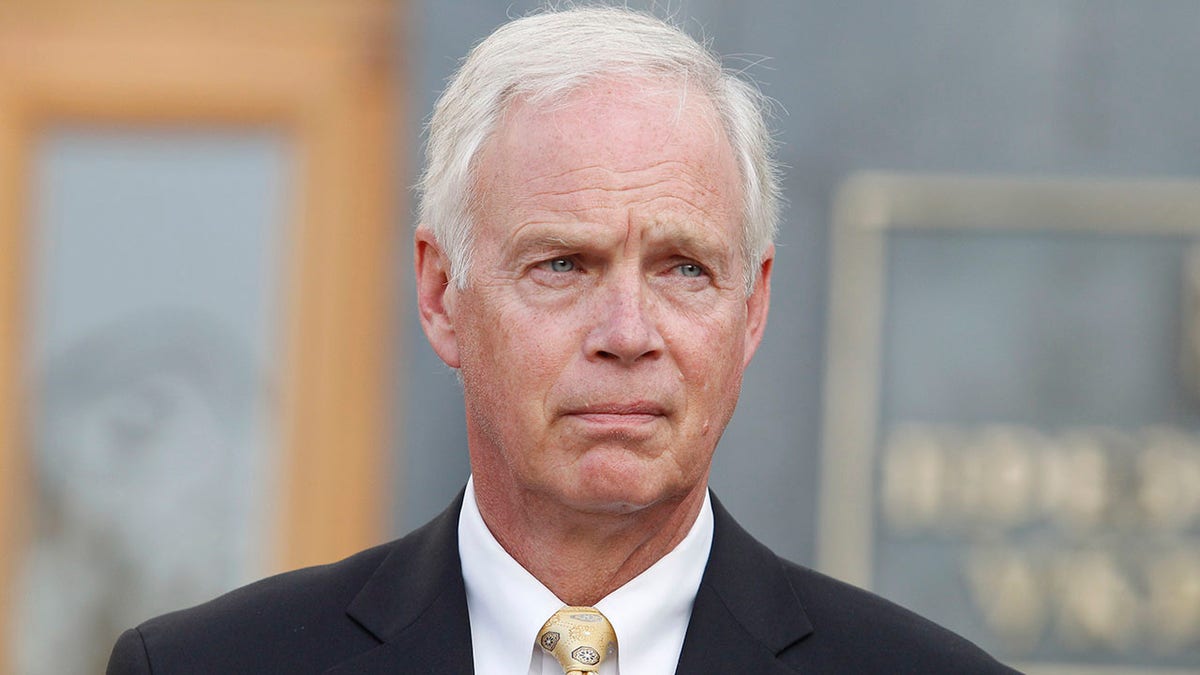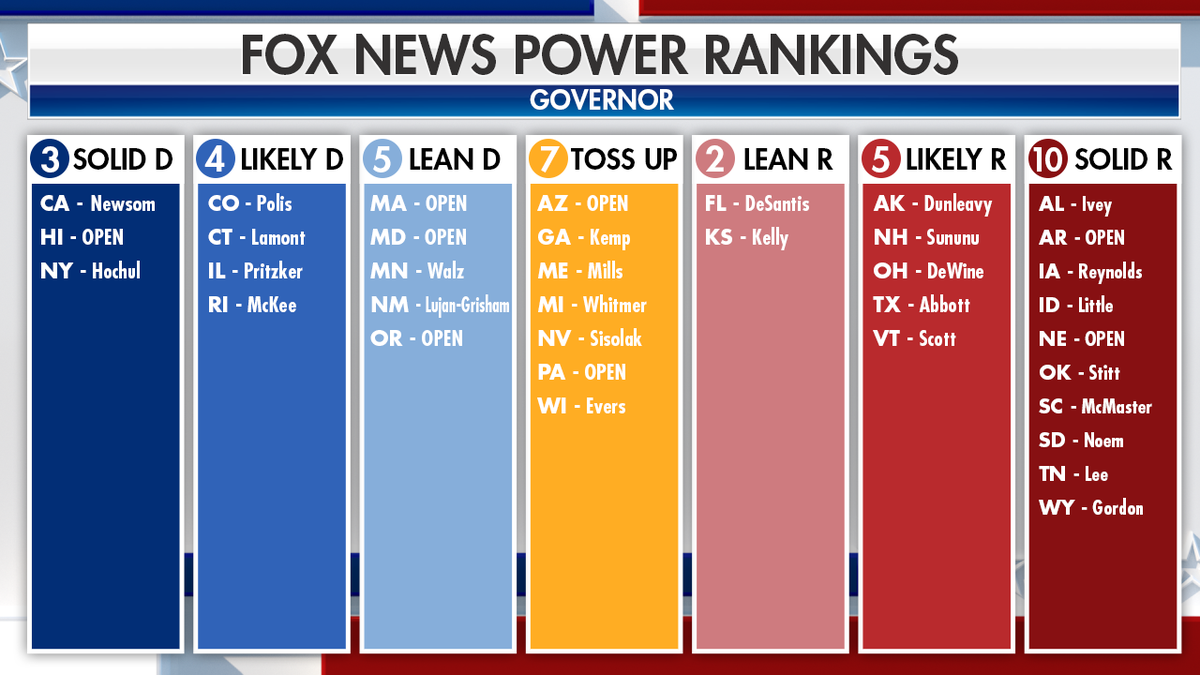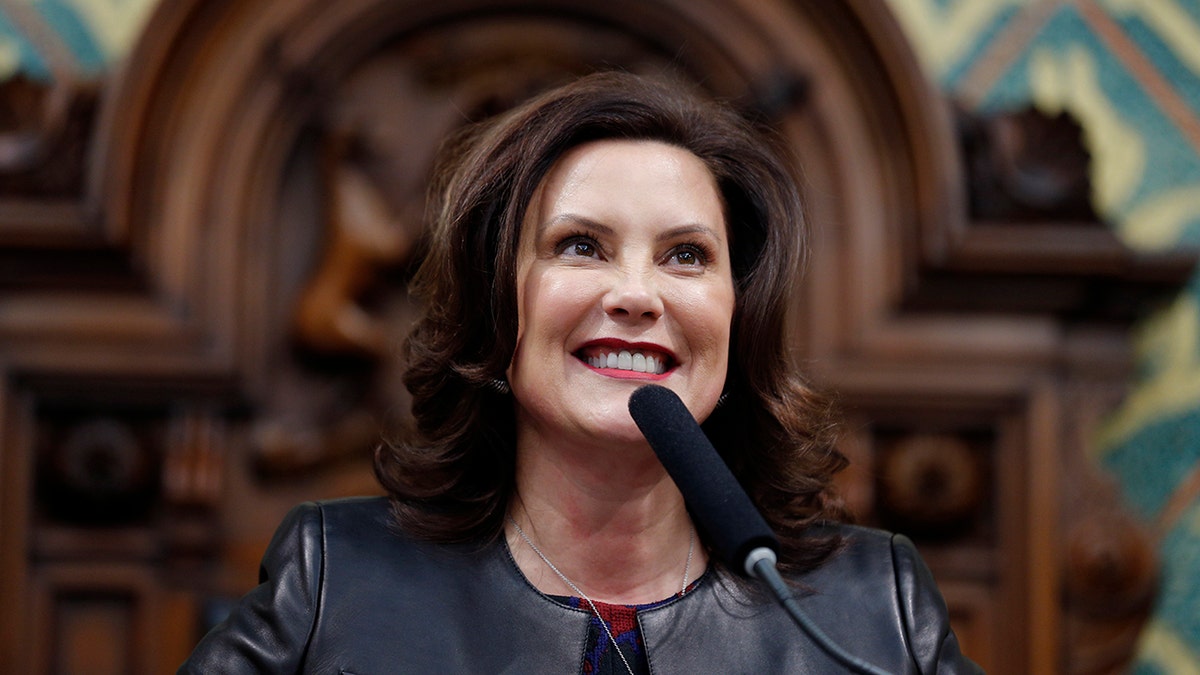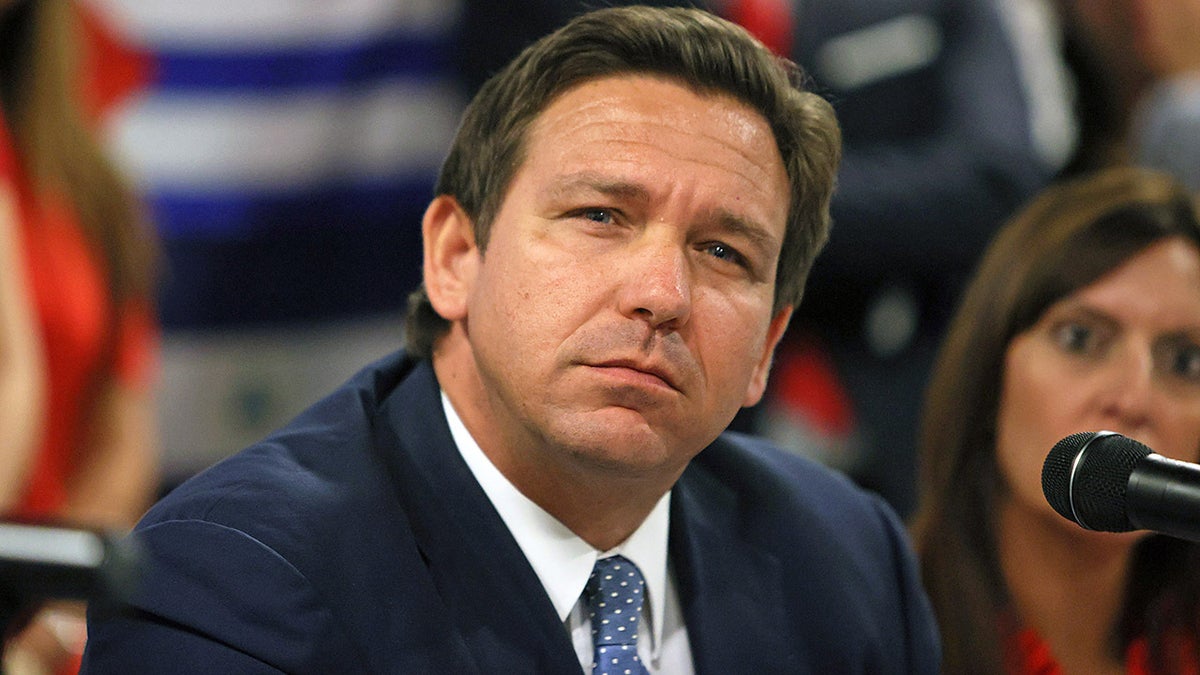Fox News' first Power Rankings of 2022 election cycle released
Bill Hemmer and Dana Perino discuss the Senate and governor's races on 'America's Newsroom'
On Nov. 8, America will decide which party takes control of Congress. The results of 435 House races and 34 Senate races will determine whether Democrats hold on to their majorities or Republicans take power for the first time during the Biden administration. President Biden’s agenda is at stake, with a Republican victory in either chamber likely to stifle any policy accomplishments as he completes his first term in office.
Midterm elections may not get the same attention as presidential races, but more Americans are voting than ever before. 53.4% of eligible voters cast a ballot in 2018, marking the highest midterm turnout in four decades. As turnout and interest reach new highs, voters are confronting a tidal wave of breaking news and data every day.
Fox News' job is to carefully analyze all those numbers to give you a clear-eyed assessment of where each race stands. With that goal in mind, we are excited to introduce you to the first Fox News Power Rankings for 2022, for the U.S. Senate and all 36 governor's races.
This first set of rankings gives Republicans a consistent edge. That is largely a reflection of the mood of the nation, which has given Biden low personal approval ratings and the Democratic Party a small deficit in generic ballot polling. Democrats have an opportunity to flip at least one Senate seat and a pair of gubernatorial races, but their prospects will depend heavily on the country’s trajectory this year. Republicans can win fewer toss-up races and still get over the 51-seat line, so they are the slight favorites to take control of the upper chamber. They are poised to win more gubernatorial races as well.
These rankings combine polling data, partisan lean models, electoral performance and factors like incumbency to assess the competitiveness of each race. If you’re unfamiliar with the Power Rankings or want to know how they’re useful, find out more here.
Senate

All eyes on the special election seats
Three senators up for re-election this year haven’t completed a full term in office. Two of them are in extremely competitive states: Sen. Mark Kelly of Arizona and Sen. Raphael Warnock of Georgia.
Biden nabbed victories in both states in 2020, but the incumbents’ biggest advantage is their bank accounts. Kelly and Warnock have $18.6 million and $22.9 million cash on hand, respectively, far exceeding their rivals in each race, per OpenSecrets. The candidates have qualitative advantages too. In Arizona, for example, Kelly is running unopposed, while the Republicans have a deep roster of candidates, including Attorney General Mark Brnovich and Peter Thiel-backed populist Blake Masters.
At the same time, according to state partisanship modeling, the states continue to lean about 5 points to the right. Combined with Democrats’ poor approval rating and generic ballot polling (more on this later), it’s impossible to give the incumbents an edge at this stage of the race.
Republicans will be especially eager to take back Georgia, where two losses in January 2021 allowed Democrats a vice-presidential-sized majority in the Senate.
Democrats' hopes for a flip rest in Pennsylvania
Democrats’ best opportunity for a Senate flip comes in Pennsylvania. This is the only seat held by a Republican in a state that Biden carried in 2020 and where no incumbent is running. Those are the best electoral conditions on the map for Democrats this November, so expect the party machine to put significant time and money into the Keystone State.
The left’s biggest challenge in this race comes from within. The leading contenders in the Democratic primary are U.S. House Rep. Conor Lamb and Lt. Gov. John Fetterman. Lamb is a Marine veteran and Biden ally who made waves in 2018 when he wrested a House seat from the GOP, but he lacks the progressive bona fides of Fetterman, a strong advocate for universal health care and climate action. Those positions have given Fetterman a fundraising lead going into the primary.
Republicans will also choose from a crowded list of candidates. Television personality Dr. Mehmet Öz (of "Dr. Oz" fame) has the highest name recognition, but he is one of over a dozen candidates competing for the nomination. Hedge fund executive David McCormick is the leading alternative, and the battle between these two deep-pocketed hopefuls is getting uglier by the week.
The state has a small rightward partisan lean, and the Democrats' hopes to take it will fade if Biden’s approval rating and generic ballot polling fail to improve. For now, it’s too competitive to give either party the edge.
Biden’s approval rating makes left-leaning incumbents vulnerable
Biden’s approval rating is underwater by 13 points, according to our weighted average of polls, and the Democrats have a 2-point deficit in generic ballot polling, too. These numbers are hurting incumbent Senate Democrats from coast to coast.
In the east, the polling deficit should be making New Hampshire Sen. Maggie Hassan nervous about securing a second term. The Granite State moderate already has reason to be nervous: She won by a mere 1,017 votes in her 2016 race. That translates to a minuscule 0.14-point margin, making it the closest Senate fight of that year.
On the West Coast, Democrats face the same problem in Colorado and Nevada, which are ranked "Lean D" and "Toss Up," respectively. Colorado is a perfect illustration of the negative impact polling is having on the Democrats' hopes. In 2020, Biden won the state by the same margin as his national approval rating deficit. A small partisan lean toward the Democrats in the Centennial State does not make those numbers go away. That leaves incumbent Sen. Michael Bennet with a modest edge. The same reasoning applies to Sen. Catherine Cortez Masto in Nevada, a state that leans a little more to the right.
Vacancies in North Carolina and Ohio make the states competitive for now
Given Democrats’ poor polling, readers might expect that the races in North Carolina and Ohio would tilt further rightward. However, both of these seats feature retiring Senators and crowded GOP primary fields, which puts the Republicans on less stable footing than they might like.
In North Carolina, former state Supreme Court Chief Justice Cheri Beasley is the clear front-runner for the Democratic nomination (she is part of a "wave of Black candidates who are rapidly altering the dynamics of Senate campaigns across the country," per Politico). Meanwhile, Republican voters must choose between former North Carolina Gov. Pat McCrory, who has praised Senate Minority Leader Mitch McConnell’s stance on the January 6 committee, and Trump-endorsed rival Rep. Ted Budd.
WHY 2022 MIDTERMS COULD MIRROR 2010 BLOODBATH FOR DEMS
It’s a similar story in Ohio, where moderate hopeful Rep. Tim Ryan has vastly out-raised his Democratic opponents, while Republican contenders include author J.D. Vance, former state treasurer Josh Mandel and state Sen. Matt Dolan. They are all locked in a bruising battle ahead of their May 3 primary.
Republicans have an advantage in these states, but at least until the dust settles from those primaries, both races are rated "Lean R" for now.
Incumbent Republicans have an edge in Florida and Wisconsin
The GOP also has an edge in Florida and Wisconsin, where Republican senators are both seeking third terms. Two-term senators have the best possible incumbency advantage, with an average 5.2-point gain, according to a FiveThirtyEight analysis of Senate results.
In Florida, Sen. Marco Rubio, who has deftly aligned himself with modern conservative ideas, is up for re-election. Florida has veered red in recent elections, but he faces a formidable competitor in U.S. House Rep. Val Demings, the former Orlando police chief. In Wisconsin, Sen. Ron Johnson looks stronger than any Democratic opponent, but remember that Biden carried the state in 2020 on a 0.6-point margin.

Sen. Ron Johnson holds an edge over any Democrats challenging him for his Senate seat. (STR/NurPhoto via Getty Images, File)
If polling continues to trend south for the Democrats, expect these races to shift more comfortably toward the Republicans. For now, both are "Lean R" seats.
Keep an eye on Alaska
Alaska has elected a Democrat to federal office just once in its last 20 races. Suffice to say that the Senate seat up for reelection in the Last Frontier will remain in Republican hands this November.
It’s less certain whether incumbent Sen. Lisa Murkowski will win a fourth term. Alaska will employ a ranked-choice voting system this year, becoming just the second state to do so (after Maine). In ranked-choice elections, voters order the candidates on the ballot by preference. In this election, voters will choose from the top four candidates after a nonpartisan primary, so a voter will put a "1" next to their top candidate and keep numbering up to "4" for their least favorite. Voters will not be required to number all the boxes, so "traditional" voters can stick with a top choice only if they prefer.
In theory, the reforms should make it easier for Murkowski to retain her seat, since she can rely on the second-choice ballots of progressive and moderate voters, whose candidates are likely to be knocked out of the race first. Even so, ranked-choice voting is a new beast, and there are too many unknowns about the candidates and voter preferences to conclude that Murkowski will take it home. Expect forecasters to watch the returns from Alaska very closely on election night.
Murkowski’s toughest competition comes from the right: Kelly Tshibaka, the former Alaska Department of Administration commissioner and Trump ultra-loyalist, is also running as a Republican.
Governor

Democrats are in trouble across the nation
Biden’s approval rating and electoral performance are less relevant to gubernatorial races than they are in the Senate. Even so, the mood of the national electorate toward Democrats is grim, and that is dragging down left-of-center contenders across the gubernatorial map.
Four Democratic governors are in more trouble than their prior results would suggest, beginning with Tim Walz of Minnesota and Michelle Lujan Grisham of New Mexico, whose races are "Lean D" as of today. Gov. Janet Mills of Maine and Gov. Gretchen Whitmer of Michigan are in even more danger, with their races both ranked as "Toss Ups."
One open race is also more competitive than readers might expect: Oregon, where Gov. Kate Brown is term limited. The state hasn’t elected a Republican governor since 1982, but the race is just competitive enough on current conditions to place it into the "Lean D" category.
All of the governors named above were elected on 5-point-plus margins in 2018, but the COVID-19 pandemic has forced every governor to make difficult choices on issues ranging from hospital capacity, to business "reopening" dates, to masks in schools. Voters are entering their third year of life in a pandemic, and they are turning against the advice given by government leaders. Consider our latest Fox News Poll, where 56% of voters said that government agency guidelines were "not useful" in helping them manage life with the disease.
Governors like Michigan’s Whitmer and Oregon’s Brown have been the statewide faces of the pandemic for most of their current term in office, and pandemic exhaustion might give Republicans just enough of a window to flip several more states than usual.

Gov. Gretchen Whitmer’s re-election bid is ranked a "Toss Up." (AP Photo/Al Goldis, File)
Both parties have easy flip opportunities
To be clear, Republicans have an uphill battle to claim a Minnesota or a New Mexico, but one state looks very good for the GOP to reclaim: Kansas. The Sunflower State is currently run by centrist Democratic Gov. Laura Kelly, but this race goes firmly in the "Lean R" column, making it the easiest flip opportunity for Republicans on the board. Kelly’s likely competitor will be Attorney General Derek Schmidt, who raised $1.6 million to Kelly’s $2 million in 2021, according to the reporting of the Kansas City Star.
The Democrats have two promising flip opportunities in the Northeast, as voters in Maryland and Massachusetts choose a new governor. Each state has been led by a center-right Republican for the last eight years, but Larry Hogan and Charlie Baker are both term limited, leaving the races wide open in 2022. Voters in both states overwhelmingly prefer Democratic candidates at the presidential level, and GOP primary voters have shown little interest in nominating centrists this cycle. Both races are rated "Lean D." If conditions improve for Biden, they will drift further left.
Seven toss-ups under current conditions
That brings us to the "Toss Up" states. There are seven on the map right now: Arizona, Georgia, Nevada, Pennsylvania and Wisconsin, plus the previously mentioned Maine and Michigan. With crowded primary fields and slim historical margins, it is too early to ascribe a competitive advantage to either party in any of these races.
CLICK HERE FOR THE LATEST FOX NEWS POLLS
Arizona and Georgia are both modestly right-leaning states that gave Biden a narrow win in 2020. Former President Trump has endorsed ultra-loyalists Kari Lake in Arizona and David Perdue in Georgia, though his seal of approval has had little impact on their fundraising ability: Lake placed fifth among GOP hopefuls with a $1.5 million 2021 haul, and Perdue trailed incumbent Gov. Brian Kemp by almost $6 million in the second half of last year. If Trump-backed candidates like these prevail during their primaries, then Republicans will need to rely heavily on rallying their bases ahead of November. If not, then the GOP gains moderates and swing voters, but has to convince its base to remain enthusiastic about candidates who haven’t received the "thumbs-up" from Trump.
Nevada, Pennsylvania and Wisconsin all have similar dynamics at play, with two caveats: These states leaned a touch more blue at the 2020 presidential election, and GOP candidates are still vying for the former president’s support in all three.
DeSantis’ road to the White House isn’t paved yet

Florida Gov. Ron DeSantis in Miami in July 2021. (Joe Raedle/Getty Images, File)
Finally, there’s Florida. As the state continues to swing rightward, incumbent Gov. Ron DeSantis is the favorite. However, DeSantis won his first term on a slim 0.4-point margin in 2018, and Democrats generally remain competitive in the state, so this race squeaks into the "Lean R" column for now. DeSantis’ most likely Democratic challenger will be former Republican Gov. Charlie Crist. He leads fundraising among his party rivals but still runs tens of millions short of DeSantis in total haul, according to the Orlando Sentinel's reporting.
Democracy 2022 on Fox News Channel
Whichever races you’re following this year, Fox News is the best place for exclusive reporting and sharp analysis. Event coverage begins March 1, when Biden addresses the nation in his first formal State of the Union. On the same night, polls close in Texas, which is holding first-in-the-nation primaries for governor and a slew of House seats.
Primaries continue from May to September, with Massachusetts the last state to set its major party candidates on Sept. 20. That is exactly seven weeks before Tuesday, Nov. 8, when voters across America decide who will control the U.S. House, 34 seats in the U.S. Senate and the 36 states where the governor's seat is up for grabs.
CLICK HERE TO DOWNLOAD THE FOX NEWS APP
As the year progresses, you will see more election analysis from the entire Fox News Politics Unit as we prepare for election night.
You will also find extensive coverage all year from the teams at Fox Business Network, Fox News Digital and Fox News Audio.
Fox News’ Brianna McClelland and Paul Steinhauser contributed to this report.







